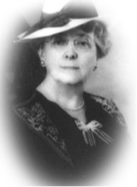 Lucy Maud Montgomery was a Canadian writer who lived for her writing in spite of a traumatic childhood and a series of misfortunes in her personal relationships. Her writing output was substantial yet she only produced one book of poetry. Her series of “Anne” novels beginning with her most famous title Anne of Green Gables (published in 1908) turned into a life time’s work and the stories have been a source of huge joy to millions worldwide.
Lucy Maud Montgomery was a Canadian writer who lived for her writing in spite of a traumatic childhood and a series of misfortunes in her personal relationships. Her writing output was substantial yet she only produced one book of poetry. Her series of “Anne” novels beginning with her most famous title Anne of Green Gables (published in 1908) turned into a life time’s work and the stories have been a source of huge joy to millions worldwide.
Maud, as she was known to family and friends, was born on Prince Edward Island in Canada in November 1874. At only 2 years of age she lost her mother to TB. Her father gave Maud up to her maternal grandparents to be looked after but this was not a happy situation for her. They were living in Cavendish and Maud suffered a lonely and bleak childhood in their care. It seems though that this time was an inspiration to her and she created the imaginary world of her character “Anne”, an unhappy orphaned girl.
Maud’s schooling was mostly in Cavendish although she did spend one year living with her father and his new wife in the town of Prince Albert. Daughter and step-mother were constantly at odds so this was not a happy time for Maud. She did, though, experience her first taste of published work while there. It was a poem called On Cape Le Force and appeared in a local newspaper. Returning to Cavendish she completed her education and decided to try for a teaching qualification by attending the Prince of Wales College in Charlottetown. She was so successful in this venture that she completed a two-year course in only one year.
It was at this time that she first experienced the awkwardness caused by the advances of men. A teacher with an overbearing religious manner was the first to try his luck and she eventually managed to rebuff him in favour of a more relaxed, younger man who became a good friend of hers, but nothing more. She did accept a proposal of marriage in 1897 but broke it off. She was, by now, a woman of considerable means but was acutely aware that “marriage was a necessary choice for women in Canada.”
One of her poems, titled, As the Heart Hopes, is about a woman yearning for a lost love and one can only speculate whether it was about herself, or someone she invented, describing that loss. Here is the last verse:

She finally succumbed in 1911, marrying a Presbyterian minister, and they moved to Ontario to live in a town known then as Leaskdale. She bore him three sons, but the second was stillborn, and the marriage brought Maud very little joy. It is incredible to think that she lived for many years with her husband’s acute melancholia while at the same time penning such joyful and uplifting stories. The Manse at Leaskdale in which she lived and wrote eleven novels eventually became a museum and is one of many places in Canada that became monuments and tributes to her work.
Despite everything she was writing even in the final year of her life and it was intended to be the last of her “Anne” books with a title of The Blythes Are Quoted. It took another fifty years though for this to be published in full. She left behind a legacy of popular stories that touched people all over the world. The famous writer Mark Twain commented on the “Anne” character thus:

Her achievements were recognised by the investiture of the Order of the British Empire (in 1935) and she was the first Canadian woman to be named a Fellow of the Royal Society of Arts in England.
The circumstances surrounding her death are unclear. Reports at the time suggested that she suffered a coronary thrombosis in Toronto but much later her granddaughter suggested that she may have taken a drugs overdose due to severe depression. A note was found by her bed which included the following:

Lucy Maud Montgomery died in April 1942, aged 68.

